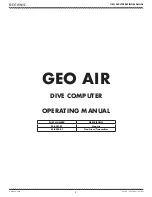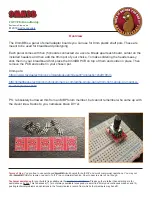
Page 20
Maintenance (CONTINUED)
10). When removing gaskets or o-rings, carefully check for damage or corrosion. Cracked, rough,
worn, elongated, swollen o-rings need to be replaced. When replacing the o-rings place grease
along the inside of the races or completely around the o-ring to help the o-ring stay in the o-ring
grove during assembly. If o-ring is pinched or not in o-ring grove the meter system will leak and
cause serious problems to personal, environment, and equipment. Collect all replaced parts and
dispose of properly. Do not weld any part of the meter system or accessories as this will weaken
the part and allow for leaks
11). Coat with anti-seize and replace all bolts and screws, torque to TCS design specifications.
12). Recommended levels of maintenance and inspection will depend upon the products being meas
ured, their corrosiveness, system pressure requirements, government or company regulations, and
age of metering system. If hydrostatic testing is required pressure should not exceed 1.5 times the
marked meter pressure. It is not recommended to pneumatically test the meter system at anytime.
13). If any part of the meter system is removed from system it should be thoroughly flushed with a
compatible liquid. After this is done, immediately refill the meter or accessory with a compatible
liquid to prevent corrosion and water build up.
¡WARNING!
Test equipment should be grounded to prevent a possible spark. Test area should have no ignition source. Operators should
wear personal protection and prevent any product exposure and environmental issues.
Storage Instructions
Short periods of non-use of the meter (a week or less) will present no problem, provided that the meter re-
mains full of product. For long periods of non-use, such as winter storage, the following procedure is rec-
ommended. Before long-term storage, a good practice is calibration of the meter to determine that it is
functioning properly.
1). To store the meter when it is left in line, flush the system with clean water until 70-80 gallons of
water have gone through the meter.
2) Pump a 50% anti-freeze / 50% water solution through the entire system (100% RV antifreeze may
be used instead). With the pump running, shut off a valve downstream from the meter, making
sure that anti-freeze solution is present at that point. Then close an upstream valve, such that the
meter remains full of anti-freeze solution.
3) Remove the register from the meter, and lubricate the drive coupling shaft. After lubrication it,
replace the register onto the meter.
When starting the system after a period of storage, check the meter's calibration as detailed earlier in the
service manual.
Summary of Contents for 700-30
Page 9: ...Page 9...
Page 10: ...Page 10...
Page 22: ...Page 22 700 30 700 35 Meter Assembly...
Page 24: ...Page 24 730 Air Eliminator Assembly...
Page 28: ...Page 28 750 30 Hydraulic Preset Valve Assembly Front Pull Side Swing...
Page 54: ...Page 54 Notes...
















































